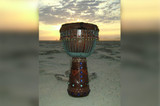Cymbal Anatomy and Sound
The ancient techniques of cymbal making have produced a range of cymbal styles that appeal to different drummers across the music spectrum. For the earliest origins of the cymbal, these instruments have been strategically crafted to produce different sounds that accent music from rock to jazz, and classical to world music. The decay, attack and overall tone and sound quality of a cymbal are directly related to its size, shape and the alloy used in its construction. Until a drummer is familiar with the nuances of cymbals and sound, a cymbal set can be a wise investment in learning the right tone and pitch for the job.
The main parts of a cymbal are the bell, ride and crash areas. Each of these areas factor into the sound of the cymbal and the acoustics it provides when played. The bell is the center of the cymbal that allows the cymbal to be attached to a drum kit or strap. It gives the cymbal stability and structure and a quick chiming sound when played.
The bow of the cymbal includes the crash and ride areas. This area runs from the bottom of the bell to the edge of the cymbal, with the ride remaining closer to the bell and the crash staying closer to the edge. The ride area of a cymbal is less responsive and takes more time to produce the sound, while hitting the crash results in an immediate interpretation of the cymbal’s sound.
The taper, or profile, of the cymbal is a factor in its sound. Flatter cymbals have more overtones, but are lower in pitch. A higher taper from bell to edge creates higher frequencies and faster sound. Cymbal weight affects the pitch, with heavier cymbals producing higher tones than lighter cymbals. Also, the size of the cymbal is a factor in sound as smaller cymbals produce higher tones than larger cymbals. These variances are also how cymbals are categorized into splash, crash, ride and other types of cymbals.
Cymbals are as varied as the artists that play them, bringing life to music in a way that no other instrument can. The science behind the construction of cymbals has been influential in the development of the sound of many genres of music, from the metals used to the overall size, shape and finish of a cymbal.
Recent Posts
-
What is the Best Size Djembe for Beginners?
If you're new to the world of percussion and interested in learning the djembe, you're in for a t …16th Jul 2024 -
The Benefits of Becoming a Drumming Teacher: Transforming Passion into Profession
Why become a drumming teacher? Becoming a drumming teacher is an excellent way to share your pas …22nd May 2024 -
What Makes the Djembe Drum a Spiritual Instrument in African Music?
Origin and history of the Djembe drum The Djembe drum originates from West Africa and holds sign …16th May 2024



